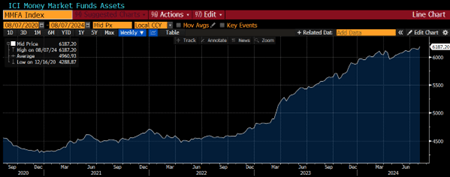Long-term strategic fixed income allocation
- 08.12.24
- Markets & Investing
- Commentary
Doug Drabik discusses fixed income market conditions and offers insight for bond investors.
Market investors have a multitude of reasons for the strategic allocation of their portfolios. This is no surprise as everyone's financial situation is unique, ranging from sources of income to necessities, to uses of discretionary funds. The flexibility offered through individual bonds translates well for tailoring individual financial goals and needs. On a higher level, many investors’ fixed income allocations carry the primary goal of preserving capital or keeping individuals wealthy when they typically have retired from their primary source of income.
Over the last couple of years, bond market yields have elevated to levels not seen in almost 17 years. Unfortunately, the opportunity to benefit from these higher rates of return is not guaranteed to be available in the future. For well over a year, the Treasury rate curve has been inverted. When the economy gets overheated and pricing inflates, the Fed raises Fed Funds to slow things down. Long term rates can decline when investors feel this could cause a slowdown in the economy. An inverted curve naturally attracts investors to short term investments since a higher rate of return is offered on short maturing bonds versus longer maturing bonds. The Investment Company Institute (ICI) reports that money market assets have climbed to a staggering $6.19 trillion.
A recent third-party Harris Poll conducted for the Guardian showed that nearly 3 in 5 respondents felt the U.S. was in a recession. Whether we are officially in one or not may not matter if the majority of Americans are feeling less sure about their financial security or how the current markets will affect their financial position. If the economy is indeed slowing down and employment data is weakening, it is not farfetched to rationalize interest rates will continue to fall. The green line in the graph shows current interest rates and the higher levels associated with short holdings. The red line (for illustrative purposes) depicts how the future yield curve could look if employment and economic data continue to decline. This is the dilemma investors face. It is beneficial to earn 5% to 5.5% in short rates especially for funds kept short for liquidity needs. For funds associated with long term strategic planning, reinvestment risk is elevated. Earning 5.25% for 30 or 60 days may not offset 2% future rates should the economy go where a majority of people think it will. Locking into 4% to 5% rates for longer may provide a more conservative and beneficial investment while reducing reinvestment risk.
The author of this material is a Trader in the Fixed Income Department of Raymond James & Associates (RJA), and is not an Analyst. Any opinions expressed may differ from opinions expressed by other departments of RJA, including our Equity Research Department, and are subject to change without notice. The data and information contained herein was obtained from sources considered to be reliable, but RJA does not guarantee its accuracy and/or completeness. Neither the information nor any opinions expressed constitute a solicitation for the purchase or sale of any security referred to herein. This material may include analysis of sectors, securities and/or derivatives that RJA may have positions, long or short, held proprietarily. RJA or its affiliates may execute transactions which may not be consistent with the report’s conclusions. RJA may also have performed investment banking services for the issuers of such securities. Investors should discuss the risks inherent in bonds with their Raymond James Financial Advisor. Risks include, but are not limited to, changes in interest rates, liquidity, credit quality, volatility, and duration. Past performance is no assurance of future results.
Investment products are: not deposits, not FDIC/NCUA insured, not insured by any government agency, not bank guaranteed, subject to risk and may lose value.
To learn more about the risks and rewards of investing in fixed income, access the Financial Industry Regulatory Authority’s website at finra.org/investors/learn-to-invest/types-investments/bonds and the Municipal Securities Rulemaking Board’s (MSRB) Electronic Municipal Market Access System (EMMA) at emma.msrb.org.




